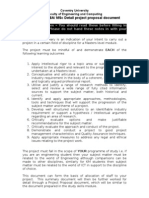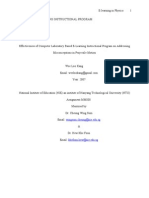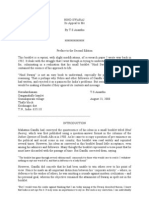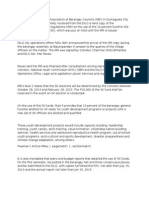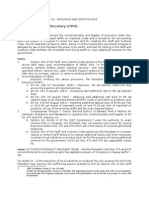Tale Danda
Tale Danda
Uploaded by
Patil Liladhar ShivajiraoCopyright:
Available Formats
Tale Danda
Tale Danda
Uploaded by
Patil Liladhar ShivajiraoCopyright
Available Formats
Share this document
Did you find this document useful?
Is this content inappropriate?
Copyright:
Available Formats
Tale Danda
Tale Danda
Uploaded by
Patil Liladhar ShivajiraoCopyright:
Available Formats
Tale-Danda follows the historical narrative in which the present is understood by returning to the past.
The playwright has taken the theme for his play from the history. It tells the story of Basavanna, a poet and social transformer who is believed to have lived in 12th century in Kalyan (present Karnataka). Tale-Danda goes back in time to uncover the history of the majority religion [Hinduism] turning against itself.4(Collected Plays, emphasis mine, p.p.x). The play focuses on the hierarchical structure in the caste system in Hinduism. The play unveils the various paradigms that can be connected together to form a complex syntagm. Syntagms are created by the linking of signifiers from paradigm sets which are chosen on the basis of whether they are conventionally regarded as appropriate or may be required by some rule system (e.g. grammar).5 This essay thus looks for the hidden paradigms that form the part of the underlying structure and the syntagm it creates. The play itself is considered here as a syntagmatic statement. Moreover the historical narrative which Karnad has used in the play itself is a syntagmatic structure. Synatagmatic analysis of the lay mainly focuses on the importance of part-whole relationships: Saussure stressed that the whole depends on the parts, and the parts depend on the whole (Saussure 1983, 126; Saussure 1974, 128).6 Tale-Danda is written in 1989 in the backdrop of Mandir-Mandal conflict in India. Thus we can say that the play is a syntagmatic exposition of the Mandal and Mandir controversies of 1980s. But before coming to this conclusion it is necessary to analyze the various factors that help to form this statement. It is necessary to identify and analyze the underlying paradigms in the play. A paradigm is a set of associated signifiers or signified which are all members of some defining category, but in which each is significantly different. The first paradigm that is considered here is the title of the play itself. The title Tale- Danda is a symbolic sign that signifies a larger whole. Larger meaning can be evolved from the name itself. The literal translation of Tale is head and Danda means punishment. So it means paying with your head. There are probably more painful/less ways of killing. And yet, one way that seems to have found favour over the ages, especially when a certain kind of person needs to be executed, is Tale-Danda. You think with your head, worse still, you dare to feel with your head. And thats why it must be chopped. It splits not only the body into two, but the entire human self, pride and existence. Now, if we look at the title with reference to the story in the play and the social scenario in which the play is written we can see that they are very closely connected. The concept of paying with your head is clearly visible in both the situations. The victims in both places are the common people who are being used for the needs of those in the power. The commoners (Sharanas) in the play are being used according to the whims of Basavanna and others. Sharanas opposed idolatry, rejected temple worship, upheld equality of sexes, and condemned the caste system .But event took a violent turn when they acted on their beliefs and a brahmin girl married a low caste boy. The movement ended in bloodshed. Similarly, the common people are again the guinea pigs in the Mandir- Mandal controversies of 1980s. They are exploited as a result of religious fanaticism and political upheaval. The second paradigm that is of prime importance in the play is Basavanna, a Brahmin poet-priest of Kalyan. Moreover the intertextuality is very clear here. It goes back into the history of Kalyan (present Karnataka). Basavanna was a social reformer who revolted against the religion and caste practices in the 12th century. Basavanna advocated a new way of life wherein the divine experience was the center of life giving equal opportunity to all aspirants regardless of the gender, caste, and social status.7 He wanted the entire world to be with only one religion, where there will be no partiality among the people. He did not advise to believe in god, instead he advised to believe in themselves. Most of the people from different religion and caste converted into
his Lingayat8 religion during his period. He accepted madigas (untouchables during that period) into Lingayat religion and became the revolutionist. Basavanna conveyed the principles of religion in the language of the people, Kannada, which thus became the best means and medium of carrying conviction to them. He educated the mass through his Vachanas. Thus the century gave rise not only to a new religion but also a new form of literature (Vachana literature) which later became an asset to the Kannada literature itself. Basavanna is not just a historical character for Karnad. The important question for us to engage with is why Basavanna. The answer to this question is clear if we read the play in the light of Mandal-Mandir controversy9. Thus Basavanna is an indexical sign which leads us to a larger reality. Basavanna could not save any of his disciples from the bloodshed followed by the intercaste marriage. He was caught in the structure of the caste system and could not make the society to come out of it. Similarly the people and the political leaders of the present day society is caught in the holds of religious fanaticism by which many innocent people lose their lives in various parts of the country. Karnad through the play seeks to enforce the identity between communal and caste violence, and to show that the effects of intrareligious conflict are very similar to those of inter-religious conflict.10 Semiotic analysis mainly deals with how messages are formed and meanings are derived in a text. Meanings give shape and lend significance to our experience of reality. Various signs help us to derive the meaning. This is by analyzing the syntagmatic and paradigmatic relationships that are present in the text. Thus, in the essay we have identified and analyzed the various paradigms that lie within the play. The paradigms help to form the larger meaning that the play is the syntagmatic exposition of the Mandal- Mandir controversies of 1980s in India.
You might also like
- Comp1 Lecture NotesDocument15 pagesComp1 Lecture NotesChristian GabrielNo ratings yet
- Clubs of MumbaiDocument2 pagesClubs of MumbaiAnirudh Vaid100% (1)
- 012 2 2Document5 pages012 2 2Pooja PatilNo ratings yet
- How To Make The Research ProposalDocument1 pageHow To Make The Research ProposalvenpunnavamsaNo ratings yet
- Article Review FormDocument1 pageArticle Review FormEva Eka PraseNo ratings yet
- Al-Azawi, Al-Faliti, Al-Blushi - 2016 - Educational Gamification Vs - Game Based Learning Comparative StudyDocument5 pagesAl-Azawi, Al-Faliti, Al-Blushi - 2016 - Educational Gamification Vs - Game Based Learning Comparative StudyAnggayudha Ananda RasaNo ratings yet
- Three Men On Boat-Chapter 19 Final 10 Dec 2017Document17 pagesThree Men On Boat-Chapter 19 Final 10 Dec 2017Himank BansalNo ratings yet
- MSC Dissertation Proposal Check ListDocument1 pageMSC Dissertation Proposal Check ListKunal ChopraNo ratings yet
- MIS and Decision Making ConceptsDocument6 pagesMIS and Decision Making ConceptsMegha BhartiNo ratings yet
- Post Grad Mba/ MSC Detail Project Proposal DocumentDocument15 pagesPost Grad Mba/ MSC Detail Project Proposal Documentmailplenty9166No ratings yet
- Pedagogical Content Knowledge Needed To Teach PhysicsDocument33 pagesPedagogical Content Knowledge Needed To Teach PhysicsMrsriyansyahNo ratings yet
- Group Assignment (Article Review)Document1 pageGroup Assignment (Article Review)Feker H. MariamNo ratings yet
- Haoyuli Resume GisDocument1 pageHaoyuli Resume Gisapi-344297606No ratings yet
- What Are The Biggest Cyber Security Threats To Your BusinessDocument4 pagesWhat Are The Biggest Cyber Security Threats To Your Businessaariya goelNo ratings yet
- IAMOTDocument8 pagesIAMOTapi-27254350No ratings yet
- Chapter 1Document25 pagesChapter 1nyrediaNo ratings yet
- The Name of The Lord - Steve KubanDocument1 pageThe Name of The Lord - Steve KubanIan Benedict R. AriolaNo ratings yet
- Research Proposal DevelopmentDocument27 pagesResearch Proposal DevelopmentmanzoorelahibeNo ratings yet
- Abstract Contingent Bill (APTC Form-57)Document2 pagesAbstract Contingent Bill (APTC Form-57)vijay_dilseNo ratings yet
- Review - Vada in Theory and Practice PDFDocument12 pagesReview - Vada in Theory and Practice PDFBalram ShuklaNo ratings yet
- You Should Refer To The Assignment Guidance Notes in The Module Guide' in Conjunction With This InformationDocument2 pagesYou Should Refer To The Assignment Guidance Notes in The Module Guide' in Conjunction With This InformationRanulf SwallowNo ratings yet
- Sky Stress ManagementDocument42 pagesSky Stress ManagementProf. MadhavanNo ratings yet
- CFP Game-Based Learning - Special Issue For IEEE Transactions On Learning TechnologiesDocument1 pageCFP Game-Based Learning - Special Issue For IEEE Transactions On Learning TechnologiesRalf Klamma100% (1)
- Lecture 4 Stream of Consciousness - WoolfDocument8 pagesLecture 4 Stream of Consciousness - WoolfPăpu AwNo ratings yet
- HRM AssignmentDocument17 pagesHRM AssignmentFaheem JuttNo ratings yet
- Role of Information in Decision Making PDFDocument6 pagesRole of Information in Decision Making PDFLovedeep kaurNo ratings yet
- Master of Business AdministrationDocument15 pagesMaster of Business AdministrationAbhishek ChaudharyNo ratings yet
- EXISTENCE IS EXTERIOR - SoS 24Document3 pagesEXISTENCE IS EXTERIOR - SoS 24Prof. MadhavanNo ratings yet
- Socio-Political Thought As Conceived byDocument266 pagesSocio-Political Thought As Conceived byAlisha Agrawaal100% (1)
- Critical Review of The Article "MANAGING CREATIVITY"Document5 pagesCritical Review of The Article "MANAGING CREATIVITY"Muhammad UmerNo ratings yet
- Michael Burmester, Daniela Gerhard, Frank Thissen - Digital Game Based Learning (2010)Document264 pagesMichael Burmester, Daniela Gerhard, Frank Thissen - Digital Game Based Learning (2010)Gabriella ChandraNo ratings yet
- Unit-27 Gandhian SwarajDocument18 pagesUnit-27 Gandhian Swarajmd chishty100% (1)
- Digital Games in Schools: A Handbook For TeachersDocument46 pagesDigital Games in Schools: A Handbook For Teachersrog70No ratings yet
- Effectiveness of Computer Laboratory Based E-Learning Instructional Program On Addressing Misconceptions in Projectile MotionDocument73 pagesEffectiveness of Computer Laboratory Based E-Learning Instructional Program On Addressing Misconceptions in Projectile MotionlookangNo ratings yet
- SummaryDocument1 pageSummaryNithilan PNo ratings yet
- A Graphic Novel Adaptation A Graphic Novel AdaptationDocument7 pagesA Graphic Novel Adaptation A Graphic Novel AdaptationSanggeetha RajendranNo ratings yet
- Learning Chemistry Nomenclature: Comparing The Use of An Electronic Game Versus A Study Guide ApproachDocument18 pagesLearning Chemistry Nomenclature: Comparing The Use of An Electronic Game Versus A Study Guide ApproachIra MahartikaNo ratings yet
- Gamification For The Purpose of Eliciting Requirements A Systematic Literature Review PDFDocument21 pagesGamification For The Purpose of Eliciting Requirements A Systematic Literature Review PDFadnan naseemNo ratings yet
- Mobile and Wireless Communication Complete Lecture Notes #5Document27 pagesMobile and Wireless Communication Complete Lecture Notes #5Student Lecture Notes100% (1)
- So S30 Dec 10Document2 pagesSo S30 Dec 10Prof. MadhavanNo ratings yet
- Planning Instructional Elements: Eugenia Etkina Rutgers UniversityDocument18 pagesPlanning Instructional Elements: Eugenia Etkina Rutgers UniversityAubrey LanotNo ratings yet
- Hind Swaraj 2008Document20 pagesHind Swaraj 2008nainathechamp100% (1)
- Office of Graduate Studies: The Francis Allotey Graduate SchoolDocument13 pagesOffice of Graduate Studies: The Francis Allotey Graduate SchoolMichael AppiahNo ratings yet
- 4 Aswini MishraDocument35 pages4 Aswini MishraNaga RajNo ratings yet
- Reading INDIAN Fiction in EnglISH PYQ One Shot Sol DuDocument19 pagesReading INDIAN Fiction in EnglISH PYQ One Shot Sol DuShivam KumarNo ratings yet
- Thematic Concern and Technical Features in Karnad's Tale-DandaDocument7 pagesThematic Concern and Technical Features in Karnad's Tale-DandaIJELS Research JournalNo ratings yet
- Ravi Kant TiwariDocument9 pagesRavi Kant TiwariAnonymous CwJeBCAXp100% (1)
- Bachelors' ClubDocument21 pagesBachelors' ClubDipankar RoyNo ratings yet
- Caste Prejudices in U.R. Ananthamurthy's Samskara - A Rite For A Dead ManDocument7 pagesCaste Prejudices in U.R. Ananthamurthy's Samskara - A Rite For A Dead Mansatyaranjan bhoiNo ratings yet
- A Critical Evaluation of The Queer Theory From An IndianDocument26 pagesA Critical Evaluation of The Queer Theory From An Indiansonaiidiot14No ratings yet
- Tale DandaDocument11 pagesTale DandaNidhi D100% (1)
- Periyar University - Tale DandaDocument6 pagesPeriyar University - Tale Dandavkm_ctrNo ratings yet
- Question Answers UGDocument6 pagesQuestion Answers UGAnonymous v5QjDW2eHxNo ratings yet
- Article Chirakumar Sabha PDFDocument21 pagesArticle Chirakumar Sabha PDFDipankar RoyNo ratings yet
- Caste Gender IntersectionalityDocument7 pagesCaste Gender Intersectionalitysmahi0626No ratings yet
- 2 Post StucturelismDocument43 pages2 Post StucturelismSutanuka BanerjeeNo ratings yet
- Bhadury, Poushali (2018). “There is no such thing as a straight woman”- Queer female representations in South Asian graphic narratives. Journal of Lesbian Studies, (), 1–11Document12 pagesBhadury, Poushali (2018). “There is no such thing as a straight woman”- Queer female representations in South Asian graphic narratives. Journal of Lesbian Studies, (), 1–11simmicatherineNo ratings yet
- This Content Downloaded From 49.36.239.41 On Fri, 10 Dec 2021 14:15:47 UTCDocument12 pagesThis Content Downloaded From 49.36.239.41 On Fri, 10 Dec 2021 14:15:47 UTCCherNo ratings yet
- E019863034 PDFDocument5 pagesE019863034 PDFDr-Renjith RajanNo ratings yet
- Rajendra UniDocument16 pagesRajendra Unichaudharyharish14969236No ratings yet
- SK - Fund IRRDocument3 pagesSK - Fund IRRAl SimbajonNo ratings yet
- Art 1777 1780Document9 pagesArt 1777 1780Марк Артём Лимот АпаллаNo ratings yet
- Topic: Stipulation in Favor of Third Party ART. 1311 Par. 2Document2 pagesTopic: Stipulation in Favor of Third Party ART. 1311 Par. 2MonicaSumangaNo ratings yet
- Essay Report SampleDocument7 pagesEssay Report Sampleidmcgzbaf100% (2)
- Psalm 119-17-24 OutlineDocument1 pagePsalm 119-17-24 Outlinealan shelby100% (1)
- St. Louise de Marillac: Her Life As ParableDocument21 pagesSt. Louise de Marillac: Her Life As ParablevinformationNo ratings yet
- 307th Dec 17 To 31 1944Document35 pages307th Dec 17 To 31 1944fables_gal100% (1)
- SpeakingDocument14 pagesSpeakingВлад КравецNo ratings yet
- Professor Kevin MacDonald - Critique of JudaismDocument29 pagesProfessor Kevin MacDonald - Critique of JudaismShane Webster33% (3)
- Ibp V. Zamora: Integrated Bar of The PhilippinesDocument3 pagesIbp V. Zamora: Integrated Bar of The PhilippinesAJ Ramos BaliongNo ratings yet
- Beneficial Construction of StatutesDocument8 pagesBeneficial Construction of StatutesKumar MangalamNo ratings yet
- Ivan Lohr - Independent Contractor AgreementDocument3 pagesIvan Lohr - Independent Contractor AgreementIvan LohrNo ratings yet
- Red Hot Tips - Kissing & Oral SexDocument14 pagesRed Hot Tips - Kissing & Oral SexKatarina R.M.100% (2)
- Tanada Vs Angara DigestDocument4 pagesTanada Vs Angara DigestJM Manicap-OtomanNo ratings yet
- GLD18Document1 pageGLD18nataliecheung324No ratings yet
- ps1 - Grade 5 Social Studies - Lesson Plan 22Document7 pagesps1 - Grade 5 Social Studies - Lesson Plan 22api-668150689No ratings yet
- Coso vs. Fernandez DezaDocument3 pagesCoso vs. Fernandez DezaCarlaVercelesNo ratings yet
- Apostolic Succession ofDocument19 pagesApostolic Succession ofDaniel MckenneyNo ratings yet
- Dennis Flores. Trial GuideDocument1 pageDennis Flores. Trial GuideMark DungoNo ratings yet
- Worked Worked: Knew MET Was/Were FLY Wrote Read Live Lived Fell Feel Taken DroveDocument3 pagesWorked Worked: Knew MET Was/Were FLY Wrote Read Live Lived Fell Feel Taken DroveAlan D. MárquezNo ratings yet
- Assyrian Politics: Political Structure and MilitarismDocument5 pagesAssyrian Politics: Political Structure and MilitarismzelNo ratings yet
- SampleDocument2 pagesSampleKhyle VillarubiaNo ratings yet
- Oliver's Salon Att'y Letter 29 March 2012 (Highlighting Added)Document4 pagesOliver's Salon Att'y Letter 29 March 2012 (Highlighting Added)onlinestammfamilyNo ratings yet
- Shipping Payment Terms For RFQDocument1 pageShipping Payment Terms For RFQAamir khanNo ratings yet
- Lyrics October 1, 2017Document2 pagesLyrics October 1, 2017Goldamir Hiponia FundarNo ratings yet
- Pilot Card 1Document1 pagePilot Card 1TalyibIbrahim100% (1)
- Vocabulary Synonyms Antonyms PDFDocument134 pagesVocabulary Synonyms Antonyms PDFTusharPatelNo ratings yet
- 62 - Garcia V Executive Secretary (Sebastian)Document3 pages62 - Garcia V Executive Secretary (Sebastian)Bobby Olavides SebastianNo ratings yet
- Colorado Senate Bill 12-020Document7 pagesColorado Senate Bill 12-020NickNo ratings yet









